Dr Vino's wine blog
wine talk that goes down easy
Big oaky monsters, imports, burcak, medals – sipped and spit
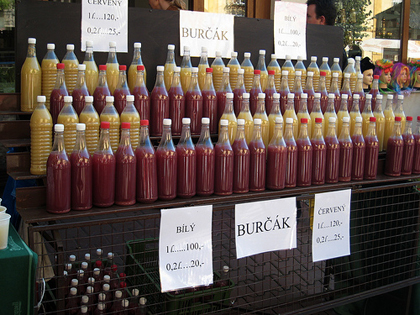
SPIT: big oaky monsters
Wine importer Kermit Lynch: “I think we have two kinds of wine markets today. One of them is what I like to call the pop wines…You’ve got your big oaky monsters trying to get 100 points. Then you have a winemaker trying to express his idea of what beauty is. Yeah, the pendulum has really swung back. For instance, a year ago we ran a sampler case of low alcohol wine. The response was enormous. I was shocked. There’s a real backlash to those oaky monsters going on.” [FT.com]
SPIT: Canadian wine from Canada
Canadian wines can contain 70% imported wine and still say “cellared in Canada” on the label. Big companies are for the practice according to The Economist, who calls it “Blended deceit from the nanny state.”
SIPPED: pre-wine!
The Burcak is flowing in Prague. The cloudy proto-wine grape drink (pictured above) is a pre-fermentation wine that revelers delight in drinking. Legend has it that the Burcak continues to ferment in your stomach, leaving a lasting buzz, er, impression. [Globespotters]
SPIT: imports
Beverage Information Group reports that overall wine consumption in the U.S. rose 0.9 percent in 2008 to 294.7 million 9-liter cases. In a reversal of a recent trend, they report that imported wines dropped 1.8 %, while domestics rose 1.9%. Their culprit: the weak dollar.
SIPPED: Stomp!
The WSJ has a round-up of wine festivals around the world that include many grape-stomping opportunities.
Alert Hodgson!
A Fresno State student wine wins “record” 49 medals. [Collegian]
High stakes and alleged fakes – Koch sues Kurniawan
 William I. Koch, the billionaire wine collector at the heart of the story The Billionaire’s Vinegar (buy on amazon), has taken yet more legal action in the world of fine wine. In an extensive complaint lodged in Los Angeles court last week, Koch makes some significant allegations. The complaint is available here as pdf and it makes for great reading. In the name of fairness and balance, these are simply allegations and it will be interesting to see how it all plays out. Whether or not you are into the fine and collectible wine market, these are fascinating developments as the cast of characters expands beyond those in The Billionaire’s Vinegar.
William I. Koch, the billionaire wine collector at the heart of the story The Billionaire’s Vinegar (buy on amazon), has taken yet more legal action in the world of fine wine. In an extensive complaint lodged in Los Angeles court last week, Koch makes some significant allegations. The complaint is available here as pdf and it makes for great reading. In the name of fairness and balance, these are simply allegations and it will be interesting to see how it all plays out. Whether or not you are into the fine and collectible wine market, these are fascinating developments as the cast of characters expands beyond those in The Billionaire’s Vinegar.
Koch alleges that five bottles he purchased through Acker Merrall & Condit were fake. The bottles were: 1947 Château Pétrus, a bottle of 1945 Comte Georges de Vogüé Musigny Cuvée Vielles Vignes, 1949 Lafleur, and two bottles of 1934 Domaine de la Romanée-Conti. Koch paid Acker $77,925 for the five bottles, purchased through private sales and auctions. He now claims they all came from Kurianwan but that source was not stated at the time of purchase.
Koch maintains that Kurniawan was the source of two Acker auctions in 2006 hailed only as from “THE cellar.” The two auctions grossed over $35 million. The complaint points to this LA Times profile of Kurniawan, which describes his preferred wardrobe is jeans and gray tshrits but that he has a Bentely and a Ferrari. The article also says that he got into wine only in the year 2000 but had already amassed a cellar of 50,000 bottles and that, “Since he started buying, prices for rare wine have skyrocketed.”
In reference to the two 2006 auctions, the filing says, “Buying and selling the same wine at the same time could also be an effort to manipulate wine prices, a scheme to pump up the price and then dump wine into the inflated market.”
Koch’s filing also states that Kurniawan owed Acker and Acker clients $10.4 million as of a November 2008 court proceeding. Acker accepted fine art and wine as collateral. Emigrant Bank also lent Kurniawan $3 million, according to the filing, and sued Kurniawan to get it back.
The filing also elaborates on sales of magnums of 1982 Le Pin and 122 bottles of red Burgundy from Domaine Ponsot. However, both sets of wines were withdrawn after winery principals raised doubts about the authenticity of the wines. Jancis Robinson has since called Laurent Ponsot “Burgundy’s Sherlock Holmes.” But where Kruniawan got those bottles remains unknown.
And to think that the movie rights for The Bilionaire’s Vinegar have already been sold! Looks like they’d better get working on the sequel already…
Corkfinger and cork recycling
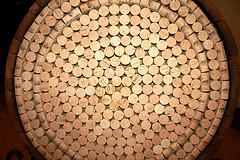 In the classic Bond film, Goldfinger tries to corner the world market for gold. Is Amorim trying to do the same thing for cork?
In the classic Bond film, Goldfinger tries to corner the world market for gold. Is Amorim trying to do the same thing for cork?
Already the largest producer of wine bottle corks, ripped from the bark of trees in Portugal, now they want their corks back!
Amorim operates a newish program under the name ReCORK America that claims to keep post-consumer corks out of landfills, a laudable goal. They have already signed up some Whole Foods locations in Northern California and they recently announced the addition of American Airlines Admirals Club lounges. Soon to be heard in taxis everywhere, “Yes, honey, I’ve got the passports but let’s go back and grab the corks and bring them to the lounge!”
Despite language in the press release to the contrary, ReCORK America currently has no specific plans on what to do with the corks they receive other than to store them in a warehouse in Napa, as stated on their web site. Contacted via email to see if their plans had congealed, they only pointed out that their partners pay to ship the corks back to the warehouse.
By contrast, the green building firm in Missouri, Yemm & Hart has collected almost 8,000 pounds (about one million corks) of post consumer corks since 2004. They make them into cork tiles for flooring and are still accepting donations. Let’s hope one day they start making cork iPhone cases!
With 13 billion corks pulled from wine bottles every year by Amorim’s estimate, there are still a lot of corks headed to landfills. Because corks are a natural product, they can also be shredded and used as mulch in the garden or added to compost as a way to keep them out of landfills. And don’t forget cork art!
A Bridge Runs through It – Mosel edition

Things are heating up in the Mosel–and it’s not just global warming. Mike Steinberger posted on Slate about planned demonstrations last Friday to protest a “four-lane, mile-long highway bridge across the Mosel river, a project that threatens a handful of Germany’s most celebrated vineyards.” Manfred Prüm, Willi Schaefer, Markus Molitor, and Erni Loosen were to be in attendance, as will wine writers Hugh Johnson and Stuart Pigott. Check out his excellent overview piece.
Decanter has a wrap on the event in which a Green party member decries the bridge as simply stimulus money. Johnson is quoted saying, “Bridges have been built from nowhere to nowhere, but don’t let that happen. Don’t think that this can’t be stopped.” And to top it off, the bridge as depicted in the above rendering is an anodyne collection of matchsticks, not even a soaring Calatrava creation!
The bridge would shorten the commute from Belgium and Holland to the Frankfurt-Hahn airport. Opponents of the bridge say it would shave only 30 minutes of the journey. The state of Rheinland-Pfalz seeks to turn the airport into a cargo hub. But it already is a hub for Ryanair, the low-cost carrier that even charges for printing boarding passes, collecting lost and found, and threatens charging for on-board toilets!
If this burns you up, Stuart Pigott, for his part, previously was reported to have supported the burning of a puppet representing the state prime minister of the state of Rheinland-Pfalz, Kurt Beck, in effigy. (Where does one get a good effigy these days?) But if you want to try another, less-combustible approach, you could try writing to the Chancellor. We received a somewhat cheesy sample letter here today, which is reproduced after the jump. Read more…
Study: points influence consumer perceptions!
Have you ever had a 92 point wine and thought it was most excellent–just because you knew it got a 92? If so, then you are not alone since that was the finding from a recent study by Michael Siegrist and Marie-Eve Cousin from ETH Zurich published in the journal Appetite. They gave 163 volunteers a taste of 2006 Clos de los Siete, a $15ish wine from Michel Rolland’s Argentina property and rated 92 points from the Wine Advocate. They told some of the participants the score beforehand, others not, and a told a third set that the wine got 72 points. Science Daily reports on the findings:
The analysis of the test results revealed that the test people who had been given the ratings with 92 or 72 points before the tasting rated the wine differently to those who weren’t given the Parker rating until afterwards. In the first two groups, the test people who had been given negative information rated the wine considerably worse than those who proceeded on the assumption that the wine was good. Those who knew beforehand that the wine had been given 92 Parker Points also found the wine better than those who only discovered the rating after they had tried the wine.
The information not only influences the sense of taste, but also how deep we are prepared to dig into our wallets: again, the test people with negative advance information were prepared to pay the least.
The researchers feel their initial hypothesis has been confirmed and conclude that the opinions of wine critics do have an impact on a wine drinker’s sense of taste. Surprisingly, the subjects did not change their opinion if they received the information after tasting. “People therefore were not simply trying to show themselves in a good light; the information really did alter their sense of tasteâ€, says Siegrist.
The results are not surprising, really. But it’s too bad the the synopsis doesn’t elaborate on what the group with no prior information thought about the wines.
I do wonder if the study is somewhat backward looking as consumers are getting more independent. Consider the Sierra Carche incident; if Robert Kenney would have just accepted that it was a 96, he would have drunk it and moved on. Instead he went to the trouble of overnighting a bottle of it to the critic in question. While a third party endorsement can certainly sway a wine consumer to a one-time purchase, increased consumer savvy has arguably led to greater independence, leaving wine evaluation as something contested and not accepting scores as given.
Siegrist et al. Expectations influence sensory experience in a wine tasting. Appetite, 2009; 52 (3): 762 DOI: 10.1016/j.appet.2009.02.002
American Chardonnay: “simple, sweet, alcoholic and false”
Dorothy Gaiter and John Brecher used their Friday WSJ column to blast a hole in the side of the barrel that is American Chardonnay, calling it, “simple, sweet, alcoholic and false.” Moreover, much of the pricey stuff isn’t getting discounted, as many other expensive wines are. They write:
So, did we find great bargains? No. We did not find cutthroat competition on price among higher-end American Chardonnay. It’s as if most wine stores these days are like developers who built homes on spec and now refuse to lower prices even in the face of weak demand. More important, most of the wines themselves weren’t good values at any price. They were too often disappointing, with too much oak, too little fruit and little care. Too many tasted like stagnant water, like pickling spices, or like vanilla flavorings added to water. They were not pleasant to drink on their own and would not pair well with any food…
We wondered, honestly, who they think their market is and we finally realized that many high-end American Chardonnays have become the Cadillac of the wine world. Their core audience is older, moneyed and comfortable with the names they’ve come to know. As a result, too many Chardonnay producers have decided that, as long as the bottle is just as heavy and the label is just as nice, they can take advantage of those customers by shirking on quality. But even General Motors decided, in the long run, that Cadillac needed more attention—not to mention younger buyers. We don’t believe that the current business model for most producers of higher-end American Chardonnay will work in the long run. We hope not.
Yeeow! Check out the whole article for more, including the ones they actually liked. “U.S. Chardonnay Has No Bargain Bin“
Some wines with age! Luneau Papin, Lopez de Heredia and Ducru
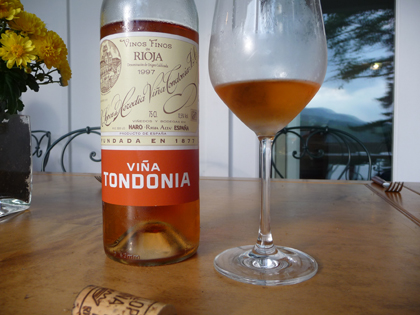
Drinking wines with age on them can be rewarding. We’ve had the chance to pop some mature wines recently; here are four with two under $30!
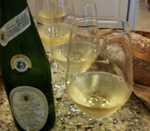 Luneau Papin, L D’or, Muscadet, 1999 About $20
Luneau Papin, L D’or, Muscadet, 1999 About $20
Muscadet is not the first thing you might think of when it comes to mature wine. But from the top producers, it can be worthwhile. I bought this wine from Crush Wine Co in NYC a couple of years ago as a late release from the winery. In the glass, it has a more golden color than most young Muscadet and aromas of delicate honey drops on wet rocks. Totally dry on the palate, the wine still has great acidity and minerality as well as a suppleness of age. We had it as an aperitif with cheeses but would also go well with seafood.
Lopez de Heredia, Rioja, rosado, 1997 About $25
Again, a rose is another category that might not leap to mind when thinking of mature wines. But with this twelve-year-old Lopez de Heredia, it’s practically the current release! If you’re looking for the freshness of a 2008 rose from Provence, well, stick to Provence. This rosado has a pink and amber hue, gorgeous mature, nutty aromas with dried rose petals and a luxurious texture on the palate. The bottle was empty too quickly!
 Marques de Murrieta, Castillo Ygay, Gran Reserva Especial, Rioja, 1985
Marques de Murrieta, Castillo Ygay, Gran Reserva Especial, Rioja, 1985
I bought this wine several years ago at Sam’s Wine in Chicago. Sadly, 24 years after the harvest didn’t work for this one and it was over the hill. As the saying goes, there aren’t great wines, just great bottles.
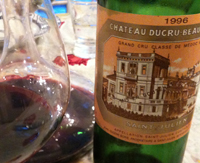 Chateau Ducru Beaucaillou, St. Julien, 1996
Chateau Ducru Beaucaillou, St. Julien, 1996
Now you might think 13 years on a top is just warming up. And for this wine you’d be right. A friend pulled this out of his cellar recently; he’d received it as part of a farewell, current release case when he left a company in Paris a few years ago. Provenance is particularly important for this wine, apparently, as some consumers have expressed frustration with bottle variation. However, our bottle was on. Still tightly wound in tannins, this big dog is a dark berry, spice, coffee flavoplosion! (Well, at least compared to these others.) Structured and drinking great now, but the tannic vigor on the finish will likely bode well for many years of future enjoyment.
Find these wines with wine-searcher
Tour and taste at Newport’s mansions!

The Preservation Society of Newport County holds its fourth annual Newport Mansions Wine & Food Festival September 25-27. The two-and-a-half day affair, presented by Food & Wine Magazine, includes a wine auction on Friday night and gala honoring Jacques Pepin, a wine tasting on both Saturday and Sunday featuring over 150 wines, chef cooking demos and more.
On Sunday, you can experience the olde tyme bling of the mansions, the fall colors and wines with me as I will be the featured wine speaker!
The organizers have are offering $10 off any ticket purchase by entering the code DRVINO, valid through 9/14. That means that a ticket to just the Sunday grand tasting is $65 or 43 cents if you taste each wine–less than the price of a stamp! Other packages are available too for the whole weekend. Be sure to say hi on 9/27 if you are there!
Newport Mansions Wine & Food Festival
September 25 – 27
The Breakers and Marble House
Newport, Rhode Island



